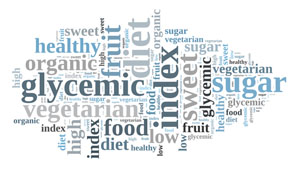 Not all carbohydrates are created equal. The glycemic index (GI) measures how any given carbohydrate containing food raises or lowers your blood sugar. Eating carbohydrates can have a profound effect on your blood sugar, especially people with diabetes. High GI foods raise your blood sugar more than low GI foods. The goal is to eat foods with a low (or medium) GI and stay away from high GI foods.
Not all carbohydrates are created equal. The glycemic index (GI) measures how any given carbohydrate containing food raises or lowers your blood sugar. Eating carbohydrates can have a profound effect on your blood sugar, especially people with diabetes. High GI foods raise your blood sugar more than low GI foods. The goal is to eat foods with a low (or medium) GI and stay away from high GI foods.
The GI is important to understand because many popular diets are based on or make positive reference to eating low GI foods, including the South Beach Diet, the Mediterranean Diet, and NutriSystem D (all reviewed on this site in the weight loss section).
While popular does not always mean better, these diets are on the forefront of where many researchers believe good nutrition is going.
HIGH GI FOODS (70+)
- White bread or bagel
- Corn flakes, puffed rice, bran flakes, instant oatmeal
- White rice, rice pasta, macaroni and cheese (packaged)
- Russet potato, pumpkin
- Pretzels, rice cakes, popcorn, saltine crackers
- Melons and pineapple
- Pizza
- Gatorade
- Waffles
- Fruit Roll Ups
- Graham Crackers, Vanilla Wafers
LOW GI FOODS(55 OR LESS)
- 100% stone-ground whole wheat or pumpernickel bread
- Beans (kidney, lentils)
- Oatmeal (rolled or steel-cut), oat bran, muesli
- Whole grain pasta, converted rice, barley
- Sweet potato, corn, yam, lima/butter beans, peas, legumes and lentil
- Most fruits, non-starchy vegetables and carrots
MEDIUM GI FOODS(56-69)
- Whole wheat, rye and pita bread
- Quick oats
- Brown, wild or basmati rice, couscous
ISSUES AFFECTING GI FOODS
- Amount of Carbohydrates eaten. (portion size is important)
- Freshness. The older a food, the higher the GI.
- Cooking Time (longer cooking time increases GI)
- Processing (For example – Fruit has a lower GI than juice
- Food Combinations (A high GI food can be eaten with a low GI food to balance the effect and moderate blood sugar)
- Nutrition (don’t eat chocolate just because it has a lower GI than oatmeal! You can’t ignore overall nutrition content)
SOURCES:
American Diabetes Association, diabetes.org, Glycemic Index and Diabetes (Accessed January 2009).
By Erich Schultz – Last Reviewed December 2012.
